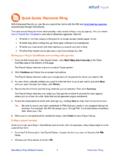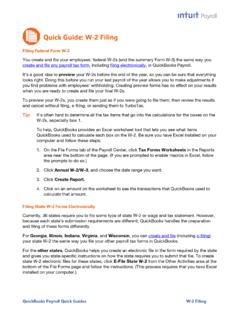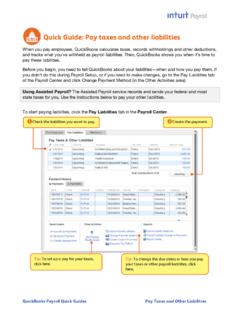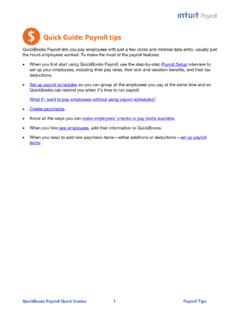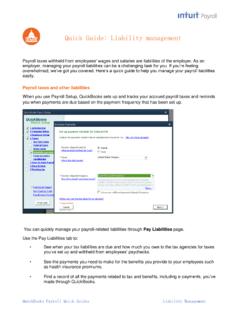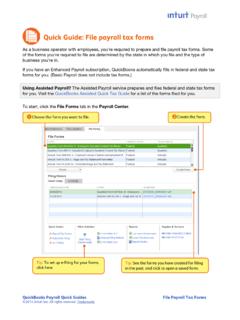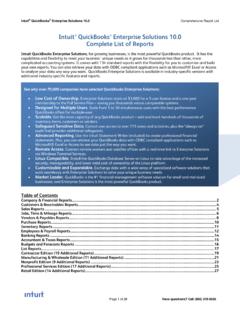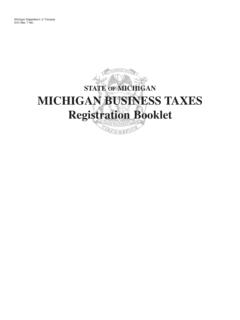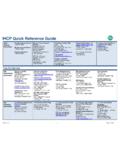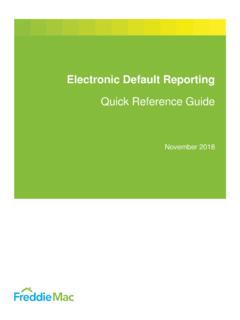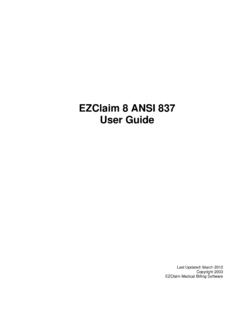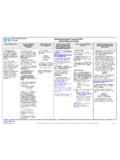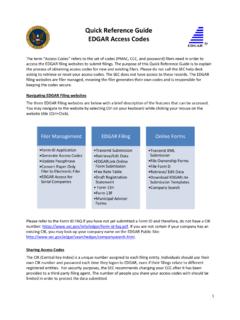Transcription of Quick Guide: Electronic payments - Intuit
1 QuickBooks Payroll Quick Guides 1 Electronic filing Quick guide : Electronic payments With Enhanced Payroll, you can pay your payroll taxes to the IRS and most state tax agencies electronically through QuickBooks. The rules around making payroll tax payments electronically also called e-pay vary by agency. You can check Intuit s Payroll Tax Compliance web site to determine agencies rules for: Whether or not they require e- payments (some no longer accept mailed checks) Whether they allow e- payments through third-party software like QuickBooks Whether you must enroll with them before you submit your first e-payment Whether they require you to also use e-file if you choose to e-pay Enrolling in the federal EFTPS Before you can e-pay your federal payroll taxes, you have to be enrolled in the Electronic Federal Tax Payment System (EFTPS).
2 Since enrollment can take a couple of weeks, you should start the process well before you plan to make your first e-payment. Tip: If you already have a 4-digit PIN and password for EFTPS, you can skip this section. 1. Go to the EFTPS web site, and click Enrollment. Follow the on-screen instructions. The IRS validates your information and sends you a 4-digit PIN through mail within 5 to 7 business days. 2. When you have your PIN, go back to and click Login. 3. Log in with your EIN and PIN and create an Internet Password. 4. Keep your PIN and Internet Password in a safe place; you ll need these to make e- payments through QuickBooks. Setting up e- payments in QuickBooks 1. From the Pay Liabilities tab in the Payroll Center, click Start Paying Electronically in the Other Activities area at the bottom of the page.
3 The Payroll Setup interview opens in a special Tax payments section. 2. If you ve never set up tax payments , Payroll Setup begins walking you through each payroll tax payment you might need to make, based on the information you ve provided about your company and its employees. Continue to step 4. 3. If you have previously set up tax payments by check, Payroll Setup lists all your payments . Click a payment you want to e-pay, and then click Edit. 4. Click E-pay as your payment method, be sure the agency listed as payee is correct, and choose the appropriate payment frequency how often this agency requires you to make a tax payment or deposit. Then click Continue or Finish. QuickBooks Payroll Quick Guides 2 Electronic filing 5. Repeat steps 3 and 4 for each payment you want to e-pay.
4 6. Click E-pay accounts from the panel on the left. Then select the bank account from which your e- payments should be withdrawn and verify (or provide) the account and routing numbers for the account. Click Finish. Enrolling with state agencies 7. Click Continue to move to the View Enrollments window. Payroll Setup provides enrollment instructions for each of the agencies for which you have requested using e-pay or indicates if enrollment is not required. 8. Click Print to print the instructions. 9. Click Finish to leave Payroll Setup. 10. Follow the instructions to enroll with each agency. Tip: If you have already enrolled in the EFTPS program (that is, you have a 4-digit PIN and a password) or with any state agency, you do not need to enroll again to use QuickBooks for e- payments .
5 Be sure to record any login credentials or PINs that you create or are assigned during enrollment. You ll need these credentials later when you e-pay. E-paying a scheduled payroll tax payment Once you ve set up e- filing in QuickBooks and enrolled with the agencies, follow these steps to e-file a payroll tax form: 1. From the File Forms tab in the Payroll Center, choose the form you want to file and click File Form. 2. Choose your filing period, and click OK. 3. Complete the interview (if there is one), review the completed form, and click Check for Errors. You must correct any errors that QuickBooks finds before QuickBooks lets you e-file the form. 4. Print a copy for your records, and then click Submit Form. 5. Click E-File, and follow on-screen instructions, providing your agency log-in credentials (if required).
6 Check the status of your e- filing As soon as you ve e-filed your tax form through QuickBooks, you can see the status of that filing . 1. From the File Forms tab in the Payroll Center, click the E- filing tab in the filing History area. 2. Find the form you e-filed and look at the Status column for the form. Submitted to Intuit indicates that you have submitted this form through QuickBooks for e- filing . QuickBooks Payroll Quick Guides 3 Electronic filing Submitted to agency indicates that Intuit has e-filed the form with the agency on your behalf. Agency accepted indicates that the agency has received and accepted the e-filed form. It might take a day or two for the agency to process and acknowledge e-filings. In addition, you should receive a confirmation email, which can be used as proof that you e-filed the form.
7 Agency rejected indicates that the agency has received the e-filed form but has rejected it. For information on why the form was rejected, click the Agency rejected link in the Status column and the View link in the Audit Trail column for the form. Tip: If you aren t seeing any change in the E- filing table, you can refresh it by clicking the Refresh link.
